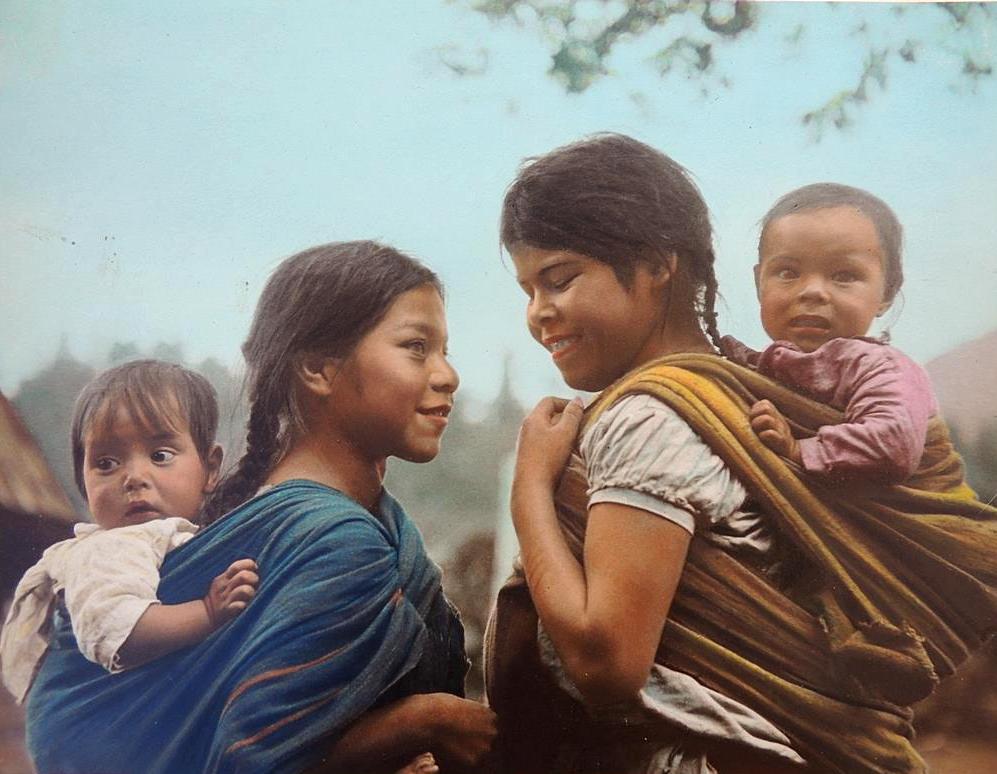
Latin American Ethnicity: Ethnic Groups

Figure 1.--Many Latin American countries have very substantial Native American and Mestizo populations. Mexico and Guatemala have the largest Native Aamerican populations in Central America. The Andean Region (Colombia south to Bolivia) and Paraguay have the largest Native American populations in South America. These girls are Mexica. I think they are young mothers with their babies and not sisters, probably during the 1930s. Photographer: German-born Hugo Brehme (1882-1954). He is one of the most important early Mexican photgraphers. He traveled to Mexico in 1905 and fell in love with the country. He spend most of the rest of his life there. He sought to capture the spirit of the country. Only a few years after he arrived the Mexican Revolution engulfed the country/. He is widely seen as the most important photographer of the Revolution (1910s).
|
|
Ethnically the population of the Latin America is extremely diverse. The indigenous population was Native Americans. There was a large and already diverse population living throughout the Americas. A very large, but debated number of Native Americans perished during the European conquest (especially the 15th century). European avarice and mistreatment was a factor, but the primary factor was the unknowing introduction of European diseases to which the Native Americans had no resistance. Even so, Native Americans are a major component of the ethnic mix in many countries (the Andean countries, northern Central America, and Mexico). Europeans colonized the Americas beginning with Columbus' voyage (1492). Spain and Portugal were at first the major colonial powers and dominated South and Central America. The Spanish also attempted to control North America, but lacked the naval power to exclude the other Europan maritine countries. The English and French fought over North America with the British eventually defeating the French in the French and Indian wars which included important Caribbean battles. North America was this largely settled by the British and subsequently other European immigrant groups. Other countries also participated in the colonial process, including Denmark and the Netherlands. All except the Russians left an ethnic foot print, but it is the British who dominated. This ethnic mix was significantly widened by the importation of captive Africans as slaves. This was primarily to work immensly profitable sugar plantations in Brazil and the Caribbean. Some slaves were imported by the English North American colonies, but the vast majority went to Brazil and the Caibbean wherethere are today large African-ethnic populations. Historians debate the size and cultural level of Brazilian Native Americans, but large numbers died as a result of slave raiding and disease. As a result, Africans make up a much larger part of Brazil's ethnic mox than Native mericans. The mixing of these peoples have created mestizos and mulattoes. More diversity as created by European (Italians were especially important) and Asian (China and Japan) immigration beginning in the 19th century. Japan has amall Japanee community. The British imported South Asians as indenturred laborers after abolishing slavery (Jamaica and Trinidad).
HBC

Navigate the Boys' Historical Clothing Web Site:
[Return to the Main Latin American etnicity pge]
[Return to the Main Latin American page]
[Return to the Main countries page]
[Introduction]
[Activities]
[Biographies]
[Chronology]
[Cloth and textiles]
[Clothing styles]
[Countries]
[Topics]
[Bibliographies]
[Contributions]
[FAQs]
[Glossaries]
[Images]
[Links]
[Registration]
[Tools]
[Boys' Clothing Home]
Created: 7:48 PM 2/17/2014
Last updated: 4:52 AM 2/20/2014



